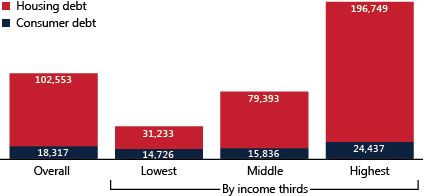Near-Retirees Are Holding Substantial Debt
April 2013Four out of five households approaching retirement in 2010 held debt
In 2010, 80.2 percent of near-retirees held household debt. A similar share of near-retiree households have held debt throughout the past two decades. 1,2
The average debt among near-retirees was over $100,000
Mean household debt among all near-retiree households in 2010 was $120,871. Among near-retiree debt holders, the mean debt was $150,633.
The majority of this debt was housing debt
In 2010, mean housing debt among near-retiree households was $102,553. The mean for consumer debt was $18,317.
Housing debt was highest among higher income households
The mean housing debt for near-retiree households in the top third of the income distribution in 2010 was nearly $200,000. For the middle and bottom income thirds, the mean values were $79,393 and $31,233, respectively.
Consumer debt figures were more consistent across the income distribution
Among near-retirees in the bottom third of the income distribution, mean consumer debt in 2010 was $14,726. Among households in the middle and highest thirds, the mean values were $15,836 and $24,437, respectively. However, lower income households had much higher consumer debt-to-income ratios.

| By income thirds | Housing debt | Consumer debt |
|---|---|---|
| Overall | 102,553 | 18,317 |
| Lowest income third | 31,233 | 14,726 |
| Middle income third | 79,393 | 15,836 |
| Highest income third | 196,749 | 24,437 |
Background
- Extensive household debt is a significant policy concern in a variety of contexts, including retirement security.
- The costs of servicing debt can reduce the amount of money available for retirement savings.
- When debt is carried into retirement it can reduce savings and other assets and decrease an individual's ability to respond to health and income shocks. 3
Key Terms
- Near-retirees refers to households headed by persons aged 50–61.
- Household debt includes housing debt and consumer debt.
1 Anguelov, Chris E. and Christopher R. Tamborini. 2010. "Retiring in Debt? An Update on the 2007 Near-Retiree Cohort." Social Security Bulletin 70(4): 69–76.
2 Anguelov, Chris E. and Christopher R. Tamborini. 2009. "Retiring in Debt? Differences between the 1995 and 2004 Near-Retiree Cohorts." Social Security Bulletin 69(2): 13–34.
3 As Anguelov and Tamborini (2009) note, however, debt levels do "not necessarily portend financial problems."
SOURCE: All statistics referenced are from the Survey of Consumer Finances (SCF).
NOTES: All content is simplified for presentation. Please see source material for full details and caveats.
The findings and conclusions presented in this summary are those of the authors and do not necessarily represent the views of the agency.